Activated Learning Gallery
We are so darn proud of our book, which has just exceeded 10,000 copies sold and has been a bestseller since it hit the shelves in 2022. It is available for order through Guilford or on Amazon. The book provides research and deeper explanation to help you understand and explore the Activated Learning approaches we show you on this website. Each chapter is broken into five parts so it is PERFECT for a small group of teachers to divvy up, read, and then come together to discuss. Not too long. Often a little funny. Sometimes emotional. Adele Diamond thinks every teacher should read it – who are we to argue? We hope you love it!

Read on… after you teach your students about executive functions, you can use their EF-literacy and skills to drive better self-regulated learning. These pictures are only a small fraction of the diverse, unique, creative EF-based teaching you can find on Laurie’s twitter feed, @LCFaith. They show a good range of Activated Learning implementation…
Firstly, check out Meg and her amazing class modeling the Activated Learning approach. Over the course of many months of implementing this approach, Meg and her class have built a giant knowledge base about each other as learners, a very supportive rapport, and a deeply strategic attitude. It was a real challenge to capture her writing AND the students’ participation, so we snuggled them up around the board. In real life, students stay in their normal places. There are several more videos like this on the Activated Learning Youtube channel.
@MsClements_, Scott Young Public School, ON, Canada
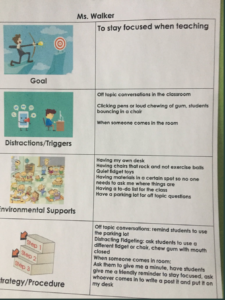
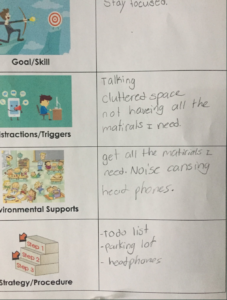
Stephanie developed this worksheet to help students think about the distractions/triggers/obstacles to their goals and the environmental supports and strategies they feel will help them to be successful. This is a great example of a daily, shared student assessment that helps everyone (including Stephanie) understand what her students experience and need. Notice how she has modelled self-awareness, self-compassion, self-acceptance, and a strategic approach with her teacher example. So exciting!
@mswalker_201, Scott Young Public School, ON
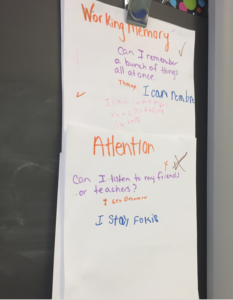
Jane started nice and slowly. As she introduced each EF, she asked students to try to notice them “AT WORK” in their everyday classroom experience. These posters filled up slowly and steadily over several weeks.
@JanieC13, Central Senior Public School, ON
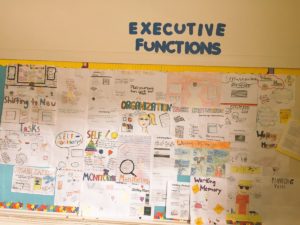
Laura assigned each group an EF. They had to research it, draw a picture of weak and strong function, and write a strategy to manage better.
@lauraduguay, Alexandra Public School, ON
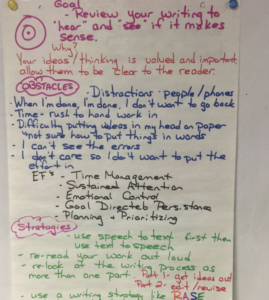
Bailie used EFs to make it easier to discuss her students’ obstacles. By drawing their attention to the role of EFs, her message, was, in essence: “We’re not making mistakes because we’re naughty, lazy, or not bright. We’re making mistakes because of natural and normal variation in EF.”
@BailieHearn, Sagonaska Demonstration School, ON
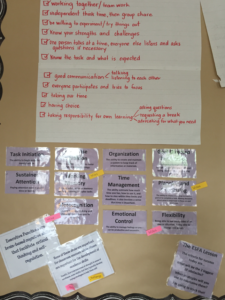
Kim made a bulletin board and displayed the EFs. When students were struggling, the class discussed EF obstacles and flagged them with post it notes. Then, the built a strategy bank to work on overcoming obstacles.
@kimberwiles, Bracebridge Public School, ON
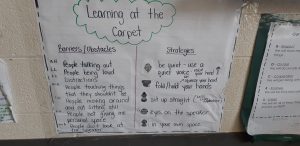
Jannah keeps this cute little BSP (Barriers & Strategies Protocol) up next to her carpet all year, referring back to it with her students. Research about teachers’ ability to implement self-regulated learning tells us that the more they understand what children are experiencing, the more they can remain calm and persist in providing choice, autonomy, and opportunity for growth.
@jannahbritton, Dr. George Hall P.S., Little Britain
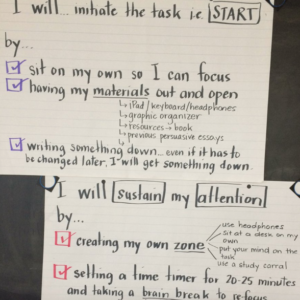
Another lesson with Kim! She worked with students to identify specific strategies to support each EF. These stay posted for easy reference.
@kimberwiles, Bracebridge Public School, ON
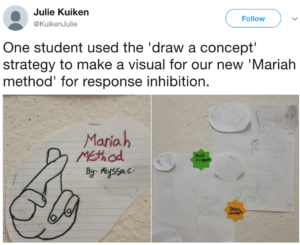
Julie’s students made their strategy bank more visual, and named a strategy after a classmate. Does Mariah cross her fingers to inhibit?
@KuikenJulie, Central Senior Public School, ON
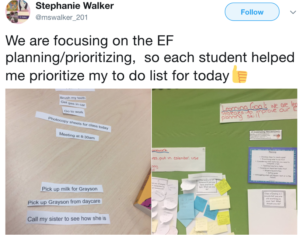
Stephanie modelled self-awareness, self-compassion, and a strategic approach for her students when she asked for help with her own goals.
@mswalker_201, Scott Young Public School, ON
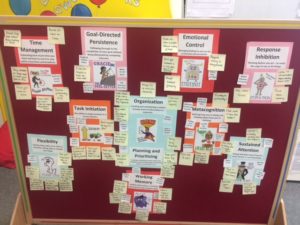
Tanya used the EFs2theRescue materials, which are perfect for younger students. Her class placed strategy ideas around each poster. These superhero-themed resources and much loved by our diverse community.
Tanya Marcusfield, London, UK

Meg displays 10 small EF posters with strategy cards underneath. The bottom half of this board displays the Ontario learning skills.
@MsClements_SYPS, Scott Young Public School, ON

Outstanding work by Activated Learning Level III trainers, conducting parent education sessions. Parents put themselves in their children’s shoes, thinking about underlying EFs and then troubleshooting the obstacles around cleaning a bedroom. Just a FABULOUS activity, especially when compared to their children’s own perceived obstacles and strategies the following day.
@Sallie_Byer and @KuikenJulie, Central Senior Public School, ON
This video describes the use of EFs2theRescue superhero characters for younger learners. It was created for the Balanced Literacy Diet website.
@merrickdavid78, Montcrest School (now Crescent School), ON
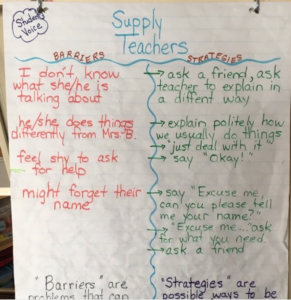
@BarrowsBatch engaged her SK/1 class in a metacognitive conversation about their experiences with supply teachers. Hmm… what is hard about this and what can we do? Such a powerful experience. I hope she pulls this out and builds on it before each day away.
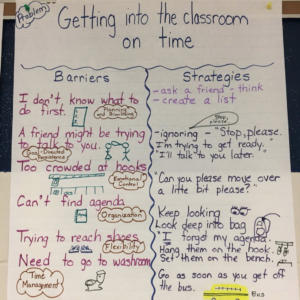
@BarrowsBatch taking her practise a step further by encouraging SK/1s to connect their barriers to EFs – this is written in brown marker on the chart. Helping students attribute their challenges to EFs will help them avoid negative attributions, such as “I don’t know what to do first because I’m not smart or not good”. “We ALL have natural and normal EF challenges,” says Ms. Barrows!

@DeRusha_D and @MsNikkiDece try out a metacognitive conversation with their kindies and are “blown away” by the barriers and strategies they came up with. Later, some students asked to have their personal strategies posted over their cubbies.

@mswalker_201 encouraged students to create a bar graph of their EF spectrum. “Wow! This is so cool to see! Each of us have strengths and needs that are so different!” The students thought the results were fascinating. The questionnaire and graphs she used can be found here.
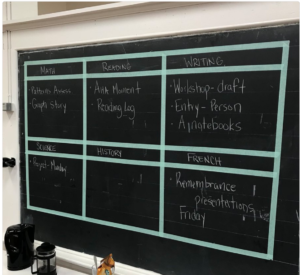
When @Houghs_Class did a barriers and strategies conversation with her students, she discovered that they were feeling distracted because they had so many things on their minds. The students themselves requested this board for the classroom as a remedy. When teachers ask students about their challenges in class, they do a DYNAMIC assessment that is context-specific, timely, and tailored.
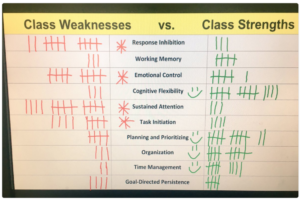
@_samtomlinson had students add tallies to a chart for their strongest and weakest EFs. Such an interesting snapshot of the dynamic in the classroom. Students may think, “OH, I’m not so different after all. So many of us struggle with similar EFs.”
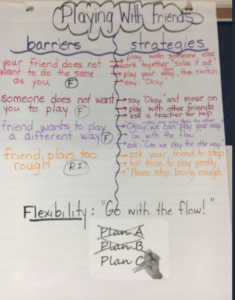
@BarrowsBatch throws down the gauntlet with this awesome barriers/strategies on an everyday challenge. We discover so much about our students’ experiences when we ask them what their barriers are. We help them build strategic, capable, resilient habits when we engage them as a team in developing strategies. It is so interesting, too, to conclude that the key EF for playing with friends at recess is Flexibility. This anchor chart can stay up all year and can grow and expand. Go with the flow, kindies!!
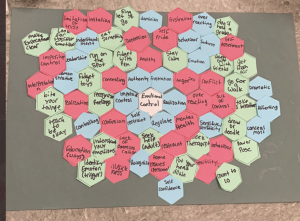

 @HayesClass wanted to have more high quality metacognitive conversations with his Grade 7 students, but it seemed like HE was doing all the talking. He found hexagon templates online and gave each group four colours. On white, they wrote an EF. On blue, they just started writing words that had to do with the EF – anything! On red they wrote the kids of barriers and challenges they had relating to the EF, and on green the wrote ideas for strategies. Then, the magic happened! Brian had his student groups cut out the sheets and try to figure out how to arrange them on a poster board before sticking them down. The students spent a lot of time arranging them, and they were having RICH DISCUSSION THE WHOLE TIME. It went longer than Brian expected, and he realized that the activity really illustrated the idea that problem solving is complex, cyclical, and mulitfaceted!
@HayesClass wanted to have more high quality metacognitive conversations with his Grade 7 students, but it seemed like HE was doing all the talking. He found hexagon templates online and gave each group four colours. On white, they wrote an EF. On blue, they just started writing words that had to do with the EF – anything! On red they wrote the kids of barriers and challenges they had relating to the EF, and on green the wrote ideas for strategies. Then, the magic happened! Brian had his student groups cut out the sheets and try to figure out how to arrange them on a poster board before sticking them down. The students spent a lot of time arranging them, and they were having RICH DISCUSSION THE WHOLE TIME. It went longer than Brian expected, and he realized that the activity really illustrated the idea that problem solving is complex, cyclical, and mulitfaceted!


